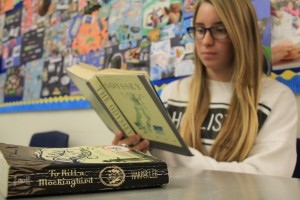Skylar Cunningham (’19) reads The Odyssey during class before she reads To Kill a Mockingbird. Photo by Julia Pacisby Cayla Nguyen, Cecilia Nguyen, and Julia Pacis, Staff Writers
Every year, freshmen are required to read The Odyssey and To Kill a Mockingbird in their English classes during their first semester at Fountain Valley High School. Although some might not appreciate the work that comes with these books, teachers hope that the students will appreciate the messages told in each piece of literature.
To Kill a Mockingbird
The novel To Kill a Mockingbird by Harper Lee tells the tale of a trial solely based on racism that was taken to court in a small, southern town during the Great Depression. The story is told through the perspective of a young girl, Jean Louise Finch, who undergoes many changes throughout the book as her father, Atticus Finch, prepares to defend Tom Robinson, the accused, in the trial. Prejudice, loss of innocence, and ethics are displayed in Jean Louise, as well as many other characters in the book.
Students appreciated the evident racism in the novel and were able to make the connection that prejudice, along with many other things, have evolved since the 1930s.
“I like how it involves crime and there’s racism in there. They got to go over what happened back then and how everything is different now,” said Brigitte Cung (‘19)
Teachers believed that the students would not only take away the simple story of the novel, but all of the lessons that were embedded in it.
“I hope they learn the story of the novel…and the social awareness…the fundamental problems that existed in society then and how those problems might still be relevant in some shape or form to our current society,” said English teacher Joseph Barro.
The Odyssey
In the epic The Odyssey by Homer, a Trojan War warrior named Odysseus faces many challenges and monsters while traveling back home to his homeland, Ithaka, before being held prisoner on an island for seven years. Odysseus encounters cyclops, sirens, witches that turn men into animals, and a whirlpool that consumes everything in its path. With the help of the goddess Athena, Odysseus is able to travel back home and fight suitors that have been going after his wife. The epic shows courage and intelligence through Odysseus, and readers learn about Greek mythology and culture.
Teachers felt that The Odyssey properly challenged the students. The epic was written differently from a typical novel that the students were used to reading. The freshmen class had to think about what the author was trying to say and the purpose of it, but were still familiar with the themes that were presented.
“We feel that we teach The Odyssey at the freshmen level because that reading level works well for freshmen students. It has understandable concepts and ideas that aren’t as perhaps confusing,” said Jonathon Lloyd, English teacher.
Students were able to draw important lessons from the epic and apply it to their own lives, as well as gain a greater understanding of Greek mythology.
“I learned a lot of new things about Greek gods and the Greek culture. I’ve always loved Greek culture so I was pretty excited to read this book,” said Anh Nguyen (‘19)
Although these books told two very different stories and lessons, teachers hoped students would not only learn about the lessons and experiences shown in the books, but be able to utilize it in real life and realize the purpose of reading them.
“We choose these [books] because we think it teaches you an essence how to enjoy your life and how to live well, and that’s what we want to do as teachers,” said Lloyd.






